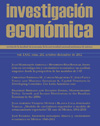CAPITAL STRUCTURES IN DEVELOPING COUNTRIES: THE LATIN AMERICAN CASE
Contenido principal del artículo
Resumen
Rajan and Zingales (1995) find that tangibility, growth opportunity, size and performance are the four common determinants for explaining capital structure across G-7 countries. In this study, we consider a sample of 590 firms from Argentina, Chile, Mexico, Peru and the United States (U.S.), to analyze whether the four common determinants also explain the capital structure in the Latin American countries. Moreover, we use a different sample of companies and a large number of years for U.S. firms and we find similar results to those reported by Rajan and Zingales (1995) more than a decade ago.
As expected, we report similar results for Chilean firms as the updated results for U.S. firms. The capital structure of Chilean firms is: positively related to tangible assets; negatively related to growth opportunities; positively related to size and negatively related to performance. This is not only true for book leverage but also for market leverage. The rest of Latin American countries show mixed results. In any case, we find two or three determinants to be statistically significant. However, those determinants are not the same when we use book leverage versus market leverage.Detalles del artículo
Citas en Dimensions Service
Los autores que publiquen en esta revista acceden a las siguientes condiciones:
a) Los autores retienen los derechos de copia (copyright) y ceden a la revista el derecho de primera publicación, con el trabajo asimismo bajo la licencia Creative Commons Attribution License que permite a terceros utilizar lo publicado siempre que hagan referencia al autor o autores del trabajo y a su publicación en esta revista.
b) Los autores son libres de realizar otros acuerdos contractuales para la distribución no exclusiva del artículo que publiquen en esta revista (como puede ser incluirlo en una colección institucional o publicarlo en un libro), siempre que indiquen claramente la publicación original del trabajo en esta revista.




